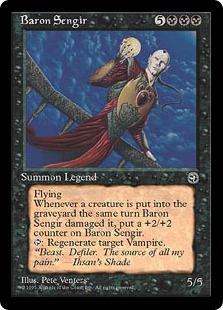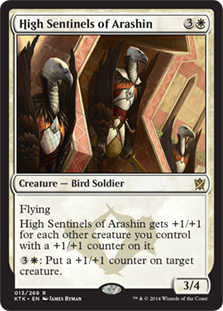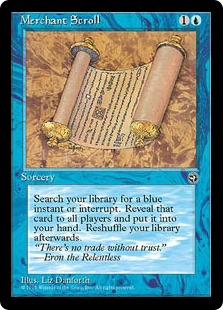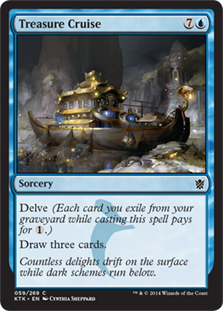I was really excited for the Khans of Tarkir pre-release last weekend. On Saturday morning I sat down with my Abzan box and imagined all the possibilities. Outlast seemed like a powerful mechanic that was perfectly suited to long, grindy games of sealed. That stuff is some of my favorite Magic to play. My pool was somewhat underwhelming, with no bomb rares in any color, but it had a good amount of outlast and morph creatures and a respectably varied removal suite. Finding ways to win with the deck seemed enticing.
Then I played my matches and absolutely hated it. In fact, I scooped up my cards in the middle of game one of the third round (of four), conceded the match, dropped from the pre-release, and went home. I had a spot in another pre-release on Sunday but chose not to attend. On Monday night we got together an eight-person draft, which I found equally unenjoyable. I first-picked a Duneblast and drafted a pretty solid Abzan deck, and again I hated every minute of playing it. Even the one game I managed to win, in which Dave McCoy conceded when I cast Dragonscale Boon on my Ivorytusk Fortress midcombat with an Abzan Battle Priest on board, was a tiresome affair.
The only other time I can recall hating Magic so much was during Homelands, when the cards were so abysmally bad that players quit the game in droves. Now, I’m not trying to compare Khans of Tarkir to Homelands. That set had basically no redeeming qualities. It was released in 1995 and yet almost twenty years later you can buy individual Homelands booster packs for $3 each. Starcity Games has 18 available right now at that price. That means nobody has any desire to crack Homelands boosters, either for card value or to toss in a wacky draft. Even if Khans somehow turned out to be the worst set ever for limited and Standard, it at least has fetchlands and some other sweet rares and uncommons to fuel desire for the set.
Khans of Tarkir is no Homelands. But why did it elicit a faint reminder of my darkest time in Magic? I’ve spent the last few days pondering how I could dislike the new set so much, and especially why I don’t enjoy playing the sort of grindy games I usually relish. Why wasn’t it fun?
I think the problem is choice. The format has too much going on. There are way too many choices to be made every turn. Abzan seems especially overworked on the choice meter because those decks want to exploit incremental advantages over many turns. This magnifies the importance of each little decision you make. I haven’t played the other clans yet. I suspect their decision trees are not quite as overwhelming, but I’m worried about them too because the overcomplexity seems baked into the entire set.
I’ve never played Lorwyn block limited, but I have heard that the format was plagued by overwhelming board complexity. A developed board might have six permanents, and you had to mentally track each one’s effect on the game at all times. Everything interacted with each other. It sounds frustrating if your goal is to analyze the various lines of play and make decisions wisely. And that’s how I’m feeling with Khans of Tarkir limited.
Here are some factors in Khans of Tarkir that add up to decision overload:
- Khans is a three-color set. This means you have to spend more time thinking about the land you play each turn. All of the dual- and tri-lands come into play tapped, so you have to take that into account when planning future turns. And in a significant number of games, you won’t hit your third color until turn six or later. That makes it harder to plan ahead.
- Because most (I assume) decks will play three colors, that means your opponent’s deck could contain over half the cards in the set. This makes playing around tricks and removal much more difficult.
- Morph is an incredibly complex mechanic. All morphs are vanilla 2/2s, and most are still relatively vanilla when they flip up, but these are by no means vanilla creatures. Morphs make attacking and blocking into massive decision trees. Do I attack with my morph? What about two of them when I can only flip one? How will my opponent block? What if they have morphs too? Am I better off waiting for them to attack me? Am I throwing away two damage by not bluffing with one morph anyway? Can I bait an awkward removal spell and then blow them out in response? It goes on and on.
- Out of 121 cretaures in Khans of Tarkir, five are vanilla: Wetland Sambar, Rotting Mastodon, Alpine Grizzly, Summit Prowler, and Tusked Colossodon. Highland Game is essentially vanilla, Venerable Lammasu only has flying, and that’s about it for simple creatures. Because of this, you have to think about pretty much every creature in play whenever you assess all the interactions on the board.
- The set is very mana-intensive. There aren’t many cheap tricks, which means almost all the spells you cast in the entire game will use a significant portion of your available mana for the turn. That makes planning your turn-by-turn mana efficiency more difficult.
That’s a lot to think about. As far as I can tell, all limited decks will grapple with these issues throughout each game. Most of this is caused by morph, which eats up space for vanilla creatures and demands a lot of mana. Morph seems like a fun mechanic with tons of depth for limited gameplay, but it inherently uses most of the complexity that a mind can tolerate within a game. When you throw in three-colored decks and five different clan mechanics, it may just be too much.
Abzan stumbles even more into this morass of complexity because of its clan mechanic. Outlast is a powerful ability, but it adds a new decision each turn to each creature that has it. Take Salt Road Patrol. A vanilla 2/5 for four mana is a solid playable in limited and useful both when attacking and defending. Normally it doesn’t take much thought to use it effectively. Add outlast, and now you have three choices instead of two on each turn: do I attack, block, or outlast? Add in the mana cost of outlasting and you have to consider whether you can afford to spend the mana outlasting because your mana is constrained, or whether you are compelled to sink some excess mana into outlasting because you are flooded. And this is before mentioning the outlast lords that give bonuses to creatures with +1/+1 counters on them, which add an amazing amount of complexity to a developed board.
Playing Abzan at the pre-release and subsequent draft, I found myself in this situation often: I have two face-down morphs, two outlast creatures, six mana, and a good trick in hand along with a midrange creature I’d like to cast. My opponent has a similar amount of mana and creatures, and a couple cards in hand. Now, what do you do? How many possible lines of play do you have to consider? How do you account for all the possible morphs and combat tricks that your opponent could have? Do you even know enough to make an informed decision? The simplest path might be to attack and force your opponent to make decisions first, thereby limiting your own decision trees to those that make sense in response. Is that a good idea? Do you want to let your opponent dictate the path of the game? Do you have any other choice? This sure makes blocking sound better than attacking, but that just pushes the difficult decisions down the road.
Khans of Tarkir limited repeatedly has put me in positions where I have an overwhelming number of strategic choices and no desire to figure out which decisions are best. When you don’t have enough information to make informed decisions, then you might as well decide randomly. At that point, why bother? It’s not fun.
I hope I’m just unfamiliar with the format. I hope it gets better.
Carrie O’Hara is Editor-in-Chief of Hipsters of the Coast.





